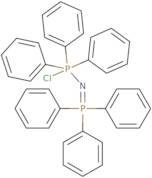Bis(triphenylphosphoranylidene)ammonium chloride
CAS: 21050-13-5
Ref. 3D-WAA05013
| 5g | Descontinuado | ||
| 10g | Descontinuado | ||
| 25g | Descontinuado | ||
| 50g | Descontinuado | ||
| 100g | Descontinuado | ||
| 25mg | Descontinuado | ||
| 250mg | Descontinuado |
Informação sobre produto
- 1,1,1,3,3,3-Hexaphenyl-3Lambda~5~-Diphosphaz-2-En-1-Ium Chloride
- Bis(triphenylphosphine)iminium chloride~PPNCl
- Bis(triphenylphosphine)iminium monochloride
- Bis(triphenylphosphoranyldiene)ammonium chloride
- Bis(triphenylphosphoranylidene)iminium chloride
- PPNCl
- Phosphine imide, P,P,P-triphenyl-, phosphorus complex
- Phosphorus(1+), triphenyl(P,P,P-triphenylphosphine imidato)-, chloride
- Phosphorus(1+), triphenyl(P,P,P-triphenylphosphine imidato-N)-, chloride, (T-4)-
- Phosphorus(1+), triphenyl(P,P,P-triphenylphosphine imidato-κN)-, chloride (1:1), (T-4)-
- Ver mais sinónimos
- Phosphorus(1+), triphenyl(P,P,P-triphenylphosphine imidato-κN)-, chloride, (T-4)-
- Triphenyl(P,P,P-triphenylphosphine imidato)phosphorus(1+) chloride
- Triphenyl-Lambda~5~-Phosphaniminium Chloride (1:1)
Bis(triphenylphosphoranylidene)ammonium chloride (BTPPA) is a synthetic compound that has been shown to have an x-ray crystal structure. It is used in the synthesis of ruthenium complexes, which are involved in oxidation reactions. The compound can also be used as a catalyst for the oxidation of hydrocarbons. Bis(triphenylphosphoranylidene)ammonium chloride has been shown to react with hydrochloric acid to form hydrogen bonds and chlorides. BTPPA has also been shown to react with nucleophiles, such as ammonia or hydroxide ions, and give products such as amines or alcohols. The molecule can be oxidized by air, giving off an orange color and forming a high-boiling liquid called phosphoric acid dichloride. This compound has been observed by nuclear magnetic resonance spectroscopy (NMR).





